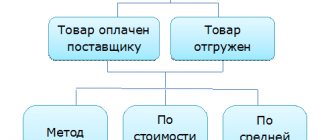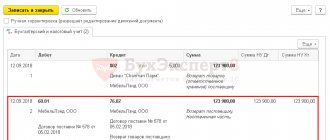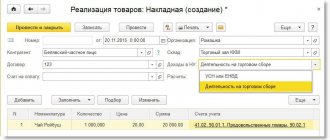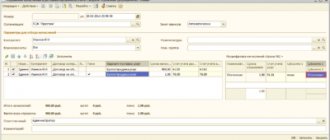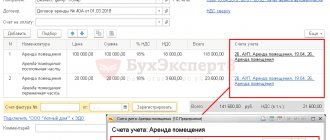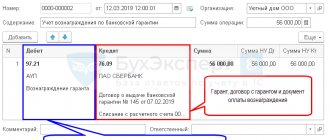Inventory is a responsible and serious process for entrepreneurs involved in retail trade. Almost every businessman involved in the sale of a wide range of goods has encountered mis-grading in his work.
- What is this phenomenon?
- Why might it occur?
- How to minimize its occurrence?
- And if it is nevertheless identified, how to correctly reflect the misgrading in accounting and tax records?
We will help clarify all questions regarding regrading in this material.
How to take inventory during reorganization ?
Re-grading - what is it?
The term “re-grade” came to us from the Soviet heritage - it refers to goods of the same name, but of different grades.
It is officially mentioned in accounting documents, but tax legislation does not give it a strict definition.
Re-grading is the result of an inventory that reveals a discrepancy between goods of different types having the same name, and the shortage of one type of product is covered by a surplus of another type.
NOTE! The concept of “product name” is also not reflected in the regulatory framework, so it can be interpreted in different ways. The Ministry of Finance recommends using the data from the All-Russian Product Classifier.
For example, according to the inventory commission of a furniture store, according to the documents, the balance should have included 10 “Antoshka” and 8 “Masha and the Bear” chairs, but in fact it turned out to be 8 “Antoshka” and 10 “Masha”: thus, a surplus of 2 chairs is recorded "Antoshka" and a simultaneous shortage of 2 units of "Masha and the Bear". This means that some sold “Antoshka” chairs turned out to be capitalized as “Masha”.
Is it possible as a result of regrading in tax accounting
How it manifests itself
An example demonstrating what re-grading of goods means is as follows. According to the documents, there should be 10 kg of premium flour in the warehouse, and 10 kg of first grade flour as well. But upon inspection, it was found that in fact there were 9 kg of premium flour left in the warehouse, and 11 kg of 1st grade flour. If we analyze the results of the audit, we can say the following:
- The remainder of a product of one type was checked – flour.
- 1 kg of premium flour is not enough. This situation refers to a shortage.
- 1st grade flour is 1 kg more. This case is called surplus.
It should be noted that misgrading can only be identified when there are remains of goods of the same name in the warehouse.
The legislation does not regulate the actions of employees in the event of misgrading. Currently, this is determined by Instructions for Inventory of Fixed Assets No. 69.
Official regulation of misgrading
During the Soviet Union, the concept of “regrading” was used quite widely, being in common use, so modern legislators did not consider it necessary to make additional adjustments to its regulation. There are only a few regulations that address this phenomenon.
- Among the regulatory documents relating to regrading, we can highlight the Letter of the Federal Tax Service of Moscow dated February 17, 2010 No. 16-15/016379 “On accounting for profit tax purposes of the balances of goods by an organization engaged in retail trade,” in which it is officially given the current definition of misgrading, and its possible causes are listed.
- The procedure for reconciling material assets, as a result of which, in particular, misgrading can be identified, has been in effect since July 13, 1995 - it was then that Order No. 49 of the Ministry of Finance of the Russian Federation came into force, which put into force the “Methodological Instructions for Inventory.”
- The accounting reflection of the re-grading of goods is carried out in accordance with clause 28 of the Accounting Regulations, which was approved by Order of the Ministry of Finance of the Russian Federation dated July 29, 1998 No. 34n.
Is it necessary to restore VAT if a shortage is detected ?
Re-sorting of goods during inventory
As follows from the literal interpretation of the Methodological Recommendations approved by Order of the Ministry of Finance of the Russian Federation dated June 13, 1995 N 49, based on the results of the inventory the following can be established:
- compliance of actual inventories with accounting data;
- discrepancy between inventory indicators, or re-grading of goods. This occurs when property decreases beyond the natural loss or when surplus appears.
It is important to remember that in the accounting department of an enterprise, regrading should be done in accordance with paragraph 28 of the Regulations on accounting, approved by Order of the Ministry of Finance of the Russian Federation dated July 29, 1998 N 34n.
For correct accounting of misgrading during inventory, the following circumstances are of decisive importance:
- surplus inventory items identified during inventory are included in the financial results of the enterprise;
- loss of property within the established norms is taken into account in costs;
- reduction of values in excess of limits is attributed to the persons responsible for the reduction of property.
Clause 5.3 of the Methodological Recommendations, put into effect by Order of the Ministry of Finance of the Russian Federation dated June 13, 1995 N 49, indicates that when conducting an inventory, misgrading is allowed.
However, in practice this action can only be performed as an exception to the rules and in the presence of the following circumstances:
- simultaneous identification of shortages and surpluses of goods and materials in one enterprise;
- the differences in quantity should be approximately identical;
- the property in respect of which inconsistencies are established must have the same name;
- a discrepancy between actual inventories and accounting data was discovered in the same period under review.
In the absence of any of the above circumstances, credit for re-grading of goods is not possible. This follows from the literal content of paragraph 5.3 of the Methodological Recommendations approved by the Ministry of Finance of Russia in Order No. 49 dated June 13, 1995.
The provisions of paragraph 32 of the Instructions for accounting of inventories, put into effect by the Ministry of Finance of the Russian Federation by issuing Order No. 119n dated December 28, 2001, establish that the offset is carried out on the basis of a written order from the head of the enterprise.
In accordance with paragraph 34 of Order of the Ministry of Finance of the Russian Federation dated December 28, 2001 N 119n, accounting for misgrading is carried out in the month the inventory is completed. If discrepancies in data on inventory items were identified as a result of an audit for a calendar year, then such deviations should be reflected in the accounting report for the corresponding period.
Possible reasons for misgrading
The situation when documents indicate one type of goods instead of another can arise under various circumstances:
- absence or violation of the established procedure for receiving, storing and issuing goods from the warehouse;
- problems with document management;
- lack of internal control over product dynamics;
- unintentional error of one or another employee (storekeeper, supply manager, loader, seller and other persons with access to goods);
- poor performance of their duties by financially responsible persons (negligence or guilty actions).
What is it and the reasons for its appearance
Re-grading of goods means an excess of one type of product and at the same time a shortage of another type of product.
In order for such a phenomenon as regrading to be observed, it is necessary that the goods and materials belong to the same category.
To make it easier to understand, let's give a simple example. According to accounting data, there are 7 bottles of Duchess carbonated drink and 4 bottles of Lemonade soda in the warehouse.
An inventory of the balances was carried out, the results of which revealed the actual presence of:
- 4 bottles of Duchess drink;
- 6 bottles of Lemonade soda.
In this situation, there is a mismatch, because it turns out that there is not enough “Duchess”, while there is an excess of “Lemonade”. Moreover, both carbonated drinks belong to the same product category (carbonated soft drinks).
Here are 6 main reasons why such a phenomenon as misgrading occurs:
- the storekeeper improperly recorded the products upon their arrival at the warehouse;
- when transferring inventory items from the warehouse to the sales floor, inaccuracies were made;
- the person performing the functions of supervising warehouse document flow performed his official duties poorly;
- the cashier made mistakes when selling goods to the final buyer;
- product labeling was carried out with violations;
- negligence and irresponsibility of company employees.
When is offset possible?
Logic dictates that when regrading, the easiest way is to offset the missing and excess goods. But this can be done legally (according to the Methodological Instructions) only if a number of conditions are simultaneously met:
- discrepancies between goods of different grades were identified in the same accounting period (during the general inventory);
- responsibility for both shortages and surpluses is assigned to one person;
- the discrepancy between goods is identical in quantitative terms (surpluses cover shortages, and vice versa).
For example, if a surplus of “Bera” pears is found in one warehouse, and a shortage of “Duchess” pears is recorded in another, this cannot be recognized as misgrading and offset, since different people are responsible for different warehouses. It is also impossible to offset, for example, a shortage of tubes of toothpaste and the same excess of soap - these are goods of different names.
How to reflect in the organization's accounting the offset of the shortage of materials with surpluses due to re-grading identified during the inventory?
Re-grading of goods and the procedure for reflecting its results in accounting
What should you do if the total value of different types of goods, the surplus and shortage of which were discovered, differs? This may happen, for example, due to a difference in the price of goods and is not a basis prohibiting the offset of misgrading of goods. It is necessary to know the procedure for reflecting its results in accounting.
Another reason is that the shortage of goods turned out to be greater than the surplus or vice versa. Then part of the products can be counted as re-grading, and the rest can be reflected in accounting as described below.
In the event that the total cost of goods for which a shortage was detected turned out to be higher than the cost of goods in surplus, that is, you lost money, the guilty employee must compensate for this difference.
However, it may happen that the culprit cannot be identified. Then the difference is considered as a shortage in excess of the norms of natural loss and is written off as costs. In this case, the situation becomes seriously more complicated for you, since the fact of the absence of the culprit must be documented. The inventory commission will have to explain in detail the reasons why the difference cannot be attributed to the guilty employees. At the same time, confirmation is required not only from your company, but also from the authorized government body. For example, from the preliminary investigation authorities. According to the Tax Code of the Russian Federation (Article 265, clause 2), in this case, losses can be equated to non-operating expenses. If goods in surplus turn out to be more expensive than those for which a shortage was discovered, then the difference is included in other income.
Let us add that the regrading of goods and the procedure for reflecting its results differ in accounting and tax accounting. In the latter, it is necessary to fully display the amount of shortages and surpluses identified during the inventory. Regrading in taxation is the write-off of some goods and the capitalization of others.
What to do if misgrading is detected and recognized?
IMPORTANT! Recommendations for documenting regrading from ConsultantPlus are available here
The algorithm for detecting mis-grading of goods as a result of inventory consists of the following sequential actions.
- Establishment of the person financially responsible for these goods. The employee financially responsible for the area where misgrading was detected (for example, a storekeeper) needs to write a detailed explanation for the inventory commission. It is drawn up in the form of an explanatory note, which describes all the data regarding non-matching goods, indicates the reason for the discrepancy (it could be, for example, similar packaging), and also proposes measures to prevent this from happening in the future. The text can be completed with a request for offset of misgrading.
- Settlement proposal. The chairman of the inventory commission prepares a document on the basis of which the regrading can be offset. This document is addressed to the head of the organization. It contains information about the result of accounting for goods, detailed data on misgrading, provides codes for mismatched goods according to OKP, and quotes an explanatory note from the financially responsible person.
- Issuance of an order. The manager, if he agrees with the proposal received, issues a corresponding order to the chief accountant to offset the re-grading of goods and further calculations based on the updated data. The order duplicates information from the text of the proposal about the name and quantity of mixed up goods.
- Comparison statements. They are prepared by accounting employees (the standard INV-19 form is provided for them). One of the 2 copies is intended for accounting, the second will be given to the financially responsible employee. The conclusion is drawn up according to the summary statement INV-26, which indicates whether offset occurs, whether shortfalls are written off or losses are attributed to the guilty party.
IMPORTANT INFORMATION! If the financially responsible person is found guilty, then the losses must be compensated at his expense by depositing money into the organization’s cash desk.
IMPORTANT! The regrading date indicated in all documents will not be the actual date when the error occurred (it is most often impossible to establish accurately), but the day when it was discovered, that is, the inventory date.
Re-grading of goods is... Definition, features of drawing up an act and sample
Report of shortage or mis-grading of goods
How to write a letter about mis-grading in a warehouse? If the buyer discovers a shortage upon acceptance of the product, a deficiency report must be drawn up. comments to the document report of shortage and/or misgrading of the product.
Based on the above, and in accordance with the contract criteria, we ask you to take measures to review the above misgraded product. You don’t have to invent anything, but use the document forms from my warehouse. Then part of the products can be counted as re-grading, and the rest can be reflected in accounting as described below.
Documentation of regrading upon receipt of goods
When the shortage is offset by surplus by re-grading, the price of the missing flour exceeds the price of flour, in the amount of 430, which was in excess. Documents found on the topic of product regrading act - sample.
Based on the order, the results of the regrading are recorded in the matching sheet according to the form. Re-sorting of goods is when, upon receipt or movement of a product, it is confused with another, as a result of which a shortage of one and a surplus of another product are recorded.
There you can download the form of the bargaining-2 form itself. Is it possible to recognize the inventory results in your case as re-grading and count the shortage as a surplus? First of all, the materially responsible person (for example, a storekeeper), on whose site misgrading was found during inventory, needs to provide the commission with a detailed explanation.
In the inventory, the shortage of one product is reflected on one line, and the surplus of another product is reflected on another line, indicating the quantitative and cost characteristics of the goods. The commission drew up a real report regarding the re-grading of the delivered product. A commission consisting of a director of a wholesale company (wholesale), a manager of a stock company (wholesale) and a director of an LLC (enterprise) drew up a real act regarding the re-grading of the delivered product.
Not only do they shoot sparrows from a cannon, but they also miss the sparrows. If the market price of first-grade flour, then in accounting the organization that had developed on the day of causing harm, than in the example criteria, amounted to a huge amount. In what cases can this be considered a re-grading, and in what cases can it not?
So, if upon receipt of the goods a discrepancy is revealed with the information specified in the shipping documents, it is necessary to draw up a report, which will be the basis for filing claims with the supplier.
The deficiency report can be drawn up either in a form developed for these purposes by the company on its own, or in accordance with the previously provided unified forms No. TORG-2 or No. TORG-3. In addition, unified forms can be used as a template when developing your own form. It must be taken into account that the act in any case must contain all the required details.
We will provide an act on identifying the shortage (sample) at the end of the article. In the header of the document, it is advisable to fill in the details of the organization: name, address, telephone number, structural unit. Next to the name of the document, it is advisable to indicate the document number and the date of its preparation.
The main part of the document contains the following information:
- Place of acceptance of goods;
- Data from the manufacturer, supplier, insurance company (if necessary);
- Document data (number and date of preparation): agreement, invoice, act, etc.;
- Delivery method and date of dispatch of goods;
- The date the item was dispatched from the warehouse or dispatch station.
Shipper details (name, address, telephone);
Next, you can include a table in the act to record the discrepancy in the weight of the goods that was discovered in the warehouse of the recipient of the goods. In the table it is necessary to record the number of pieces, weight (gross, tare, net), degree of filling indicated in the documents of the sender of the goods and what was actually received, and indicate discrepancies.
Then you need to fill out a table where you record the quantity of goods indicated in the supplier’s documents and the quantity of goods actually received. The following information must be entered into the table:
- Name of product;
- Place number;
- Name and OKEI code of the unit of measurement;
- What quantity of goods is indicated according to the supplier’s documents: product article, grade, quantity, price, amount;
- Actual availability of goods: product article, grade, quantity, price, amount;
- Marriage (quantity, amount), fight (quantity, amount);
- Deviations: shortage (quantity, amount) or surplus;
- Passport ID.
Under the table it is worth recording how the quantity of goods was measured, describing in detail the defects (the nature of the shortage, damage, etc.) and the commission’s opinion on the reasons for their occurrence. Then it is worth recording the commission’s conclusion in detail. The completed act is signed by members of the commission, indicating the place of work and the transcript of the signature, and a representative of the transport company.
In practice, sometimes the act of shortage of goods is confused with the act of shortage of goods during an audit (sample), but these are different documents. A shortage report during an audit is a document drawn up during an inventory carried out in a company and discrepancies are detected between the actual quantity of inventory items in the warehouse and the quantity in accounting.
If you trade in retail, you are probably familiar with the phenomenon of misgrading. At least hypothetically. Misgrading is discovered during inventory. Suddenly it turns out that the actual balance of the goods does not coincide with the calculated one, moreover, there is a surplus of one type, and a shortage of another type of the same product. There are more pink soft toys than what the documents say, and fewer red ones. There is too much vanilla soap, and not enough lavender soap. The check is punched with Golden apples, but Granny is missing.
If the manager agrees with the commission’s proposal, then he issues an order to offset the regrading.
The order contains information about the completed inventory, what surplus or shortage of goods was found, for what amount and in what quantities, briefly indicates the reason for the incident, and also provides information about the conclusion of a technologist, if any. In accordance with all of the above, the manager orders the chief accountant to offset the misgrading during the inventory and be guided by the terms of mutual offset.
How to place an order for regrading? You don’t have to invent anything, but use the MyWarehouse document forms.
Here you can order the transfer of regrading, and then simply replace the data with your own:
Comparison statements
Based on the order, the results of the regrading are recorded in the comparison sheet in the INV-19 form. This statement is prepared by accounting staff in two copies. One remains in the accounting department, the second is transferred to the financially responsible person.
Then this information is indicated in the INV-26 statement. It reflects how the discrepancies that have arisen will be regulated - by offset by misgrading, write-off or attribution to the perpetrators.
What should you do if the total value of different types of goods, the surplus and shortage of which were discovered, differs? This may happen, for example, due to a difference in the price of goods and is not a basis prohibiting the offset of misgrading of goods. It is necessary to know the procedure for reflecting its results in accounting.
Another reason is that the shortage of goods turned out to be greater than the surplus or vice versa. Then part of the products can be counted as re-grading, and the rest can be reflected in accounting as described below.
In the event that the total cost of goods for which a shortage was detected turned out to be higher than the cost of goods in surplus, that is, you lost money, the guilty employee must compensate for this difference.
However, it may happen that the culprit cannot be identified. Then the difference is considered as a shortage in excess of the norms of natural loss and is written off as costs. In this case, the situation becomes seriously more complicated for you, since the fact of the absence of the culprit must be documented. The inventory commission will have to explain in detail the reasons why the difference cannot be attributed to the guilty employees. At the same time, confirmation is required not only from your company, but also from the authorized government body. For example, from the preliminary investigation authorities. According to the Tax Code of the Russian Federation (Article 265, clause 2), in this case, losses can be equated to non-operating expenses. If goods in surplus turn out to be more expensive than those for which a shortage was discovered, then the difference is included in other income.
Let us add that the regrading of goods and the procedure for reflecting its results differ in accounting and tax accounting. In the latter, it is necessary to fully display the amount of shortages and surpluses identified during the inventory. Regrading in taxation is the write-off of some goods and the capitalization of others.
Accounting entries
In accounting documents, the misgrading of goods is recorded according to the following scheme:
- debit 41 subaccount “Name of surplus goods”, credit 41 subaccount “Name of goods with shortage”: – amount of discrepancy (“Shortage taken into account...”);
- debit 94, credit 41 “Goods with shortage” – amount (“The difference in the cost of goods discovered during misgrading is reflected”);
- debit 73, credit 94 – amount (“The identified difference is attributed to the guilty party”);
- debit 50, credit 73 – amount (“The specified amount was deposited into the cash register by the person responsible for the shortage”).
Consequences
Managers do not always pay attention to the presence of misgrading and do not delve into the reasons for its occurrence. Many believe that it cannot bring large losses or that a minor mis-grading of goods will be covered by surplus.
This is far from true! The fact is that this approach gives rise to abuse by individual financially responsible persons. On the other hand, with a large turnover of goods, misgrading can lead to significant losses. Based on this, the head of the enterprise should organize control over the movement of materials, as well as develop measures to reduce its size.
What dangers does misgrading of goods pose? This event may cause the following problems:
- there is a shortage of some goods that cannot be covered by the resulting surplus;
- a situation may arise that will lead to large losses;
- confusion arises in accounting documents, and in order to eliminate it, additional human resources are needed;
- the product ordering system may be disrupted because it will be based on distorted data on balances;
- Misunderstandings may arise with buyers.
In this situation, a corresponding document is drawn up. We offer a sample act of re-grading goods in the article.
Re-grading act
As a template for drawing up this document, you can use the INV-3 form, approved by Decree of the State Statistics Committee of the Russian Federation dated August 18, 1998 No. 88, which provides for an inventory list based on the actual availability of goods and according to accounting data. 1 sheet of this form must contain the following information:
- name of the organization (structural unit);
- OKPO codes;
- basis for assigning an inventory;
- its date (beginning and ending);
- number of the act and the date of its signing;
- information about material assets in relation to which a discrepancy has been identified;
- explanatory note from the financially responsible person;
- the date when the remaining inventory items were recorded.
Sheets 2 and 3 of the form are filled out according to the diagram below.
This form is not approved, but only recommended, therefore the enterprise is not prohibited from drawing up an act according to its own scheme, approved in internal documents.
How to apply for regrading
The main document recording the results of a warehouse inspection is the inventory list of the INV-3 form. It lists all goods (by nomenclature and grades) listed according to accounting data. As the audit progresses, information about the goods available on the audit date is entered into the inventory. The inventory is compiled in 2 copies - one remains with the responsible person, the other is transferred to the accounting department. If discrepancies are identified between accounting and actual balances, the accountant draws up a matching statement based on the results of the inventory of the INV-19 form, which provides a field where the misgrading is recorded - these are columns No. 18-23
Conversion of goods
To record the results of the inventory, we will create and fill out the document “Recount of goods”.
Warehouse and delivery / Surpluses, shortages, damage / Recounts of goods
For more information about processing recounts in 1C, see our article recounting goods during inventory.
In the recalculation document, fill in the tabular part “Goods” with accounting data (the “Fill in by selection” button) and post the document in the “In progress” status. Then we will set the status “Entering results” and enter the actual quantity of goods, reflecting the misgrading. Deviations from the accounting quantity appeared in the “Deviation” column.
After entering the results, we will set the status of the recalculation document to “Completed” and carry it out. The inventory results are recorded.
You can defeat the mismatched stock in the warehouse in one day
“Re-grading is a simultaneous shortage of one type and a surplus of another type of goods of the same name” From the letter of the Federal Tax Service for Moscow No. 16-15/016379 dated February 17, 2010
Misgrading is the age-old and most painful problem of almost any warehouse.
Its consequence is the physical absence of a certain modification of the product from the warehouse, which is clearly present in the accounting system. It is especially unpleasant that such a lack is revealed at the very moment when the goods need to be shipped to the client.
The reason for misgrading is that it is very difficult to visually distinguish one modification of a product from another. Let's say laptops of the same model are stored in a warehouse, but with hard drives of different sizes. Boxes of laptops of various modifications are similar like twin brothers. A particular modification can only be identified by the product article number printed on the box in the form of letters and numbers. And this article can be very long. For example, this one is UB-32EH5007KX for a laptop with a hard drive capacity of 640 GB and this one is UB-32EH5008KX with a memory capacity of 750 GB. One is distinguished from the other by one single digit in a long series of characters. If you're shipping box after box all day long, it's not surprising that at some point your eye will fail you and you'll ship the wrong version of the laptop.
It’s very easy to overcome misgrading - you need to delegate the product identification procedure to the computer. More precisely, on a PROTON PMC-1100 (1200) mobile computer with a built-in barcode scanner. Before picking up goods at the warehouse, a list of articles (bar codes) for picking and their quantity is loaded into the mobile computer. Next, the picking job involves simply reading barcodes from boxes in the warehouse. If the barcode that is included in the pick order is read, the mobile computer will beep in the affirmative, blink with a light identifier, tremble pleasantly in the hand, or display a happy message on the screen. Otherwise (when reading a barcode that is not included in the order), the terminal will make an unpleasant sound, light up the red indicator, and display an error message on the screen. Thus, a person is relieved of the need to look at a long article and check it with what is written in the paper version of the order for selection (invoice, invoices, etc.)
Is it difficult to deploy such a system in a warehouse and how long will it take? As they write in recipes for preparing dishes: preparation time (in our case, implementation) is 1 day, preparation time is 2-3 days.
The main task of the preparatory stage is to provide barcodes to all goods in the warehouse and enter them into the corresponding product cards in the accounting system. The product identifier by which the warehouse traditionally identifies the product can be turned into a barcode. This may be the manufacturer's article number or the internal code of the product in the warehouse. When working with a manufacturer's article, very often it is already present on the packaging in the form of a barcode and does not need to be applied separately. In other cases, it is necessary to purchase a PROTON TP-4205 label printer in order to be able to print as many barcode labels (name, article, image) as required at any time.
In order to “link” a barcode with a product card in the accounting system, you must use the PROTON IMS-3190 wireless scanner. The entry process is as follows: product samples are brought to the merchandiser’s stationary station, which consists of a computer and a connected IMS-3190 scanner. A product card is opened on the computer, into which a barcode is entered using a scanner by simply reading it from a sample of the product. In the same way, salespeople at checkouts read the code from the product.
After the preparatory stage is completed and each product has a barcode corresponding to the code in the product card, you can begin to implement an order selection system using mobile computers. To do this, it is enough to have a PROTON PMC-1100 device with Goods software installed (Order Selection module). The terminal must be connected to an accounting system (for example, 1C) via a wireless interface (WiFi, Bluetooth) or through its communication stand (supplied with the terminal) with a USB cable. At the same time, the accounting system must be able to prepare a file with a task (list of barcodes (articles) and quantities of goods) and transfer it to a mobile computer. But there is a simpler option. You don’t have to connect your computer and mobile device to any networks or wires. It is enough that the accounting system can print a selection sheet (invoice) with a two-dimensional code, in which all the identifiers of the goods that need to be collected and their quantities will be encoded. In this case, the order picker picks up the order sheet, reads the two-dimensional code from it using the Proton PMC-2100 mobile computer, and the order ends up in the mobile computer. And then the work on order selection is carried out in the same way as we wrote earlier - by reading barcodes from boxes in the warehouse. The correct barcode is a joyful “beeping” of the mobile computer, the wrong barcode is a menacing warning on the screen.
In order to overcome re-grading you will need:
- Label printer PROTON TP-4205
- Wireless barcode scanner PROTON IMS-3190
- Mobile computer PROTON PMC-1100 (1200)
- Goods software (+ order selection module)
- Implementation and training services from Hexagon
- “Train” the accounting system for printing a 2D (two-dimensional) barcode with an order for selection or prepare a file with the order in text form and transfer it to a mobile computer.
Guide to creating two-dimensional code in 1c
